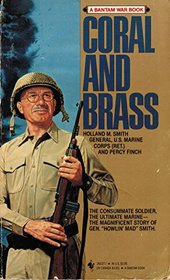Every Marine, and also those interested in the Pacific war, should read this fascinating autobiography. The Marines didn't suddenly become experts at amphibious assaults in World War II. It required a tiresome effort against a military bureaucracy in the 1930s to be ready for that conflict.
Holland M. Smith, commanded the Marines in the central Pacific during WW II. He had to fight Navy and Army brass to get the proper training for the Marines in amphibious warfare in the 1930s and get the proper tools too, i.e., landing craft, etc.
Then the Army just takes the Marine manual, slaps a Army cover on it and takes credit for it. Another problem was Navy brass thought they commanded the Marines and were the ones to make all the decisions on the landings and fighting. Fortunately some of the higher Navy brass backed Smith up. Smith also says Tarawa was a major mistake and the Marines should never have gone there. He then states the best amphibious landings were at Saipan.
Giving credit to Marine, and sometimes Navy, leaders, as well as the grunt privates with their rifles, Smith describes the bloody path across the Pacific. He finally gave up a fighting command, at the age of 64, after Iwo Jima. and returned stateside for a training command, to make way for younger leaders to gain command experience.
I was especially interested in his occasional statistics, such as over 269,000 Japanese (post-war Japanese figures) died due to the sinking of their ships by U.S. submarines, to whom he gives great credit; and to the fact that damaged B-29s were already landing at Iwo before the island was even half-way secured, eventually saving the lives of over 20,000 Army Air Corps personnel.
Holland M. Smith, commanded the Marines in the central Pacific during WW II. He had to fight Navy and Army brass to get the proper training for the Marines in amphibious warfare in the 1930s and get the proper tools too, i.e., landing craft, etc.
Then the Army just takes the Marine manual, slaps a Army cover on it and takes credit for it. Another problem was Navy brass thought they commanded the Marines and were the ones to make all the decisions on the landings and fighting. Fortunately some of the higher Navy brass backed Smith up. Smith also says Tarawa was a major mistake and the Marines should never have gone there. He then states the best amphibious landings were at Saipan.
Giving credit to Marine, and sometimes Navy, leaders, as well as the grunt privates with their rifles, Smith describes the bloody path across the Pacific. He finally gave up a fighting command, at the age of 64, after Iwo Jima. and returned stateside for a training command, to make way for younger leaders to gain command experience.
I was especially interested in his occasional statistics, such as over 269,000 Japanese (post-war Japanese figures) died due to the sinking of their ships by U.S. submarines, to whom he gives great credit; and to the fact that damaged B-29s were already landing at Iwo before the island was even half-way secured, eventually saving the lives of over 20,000 Army Air Corps personnel.




